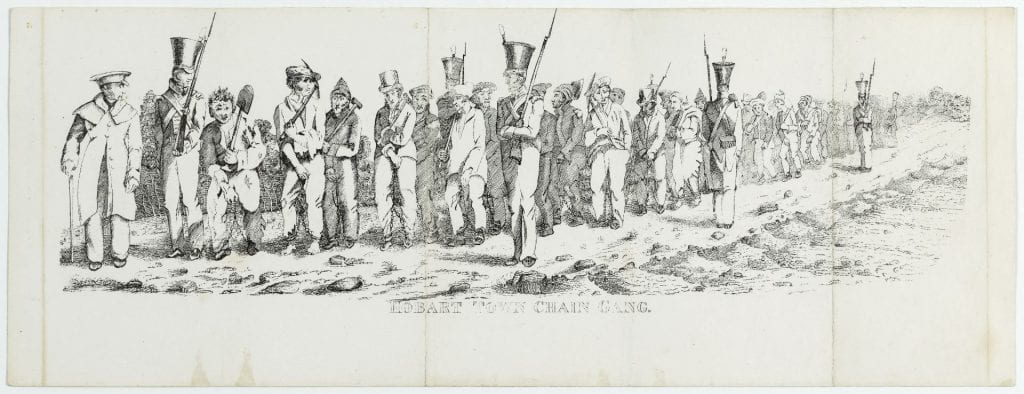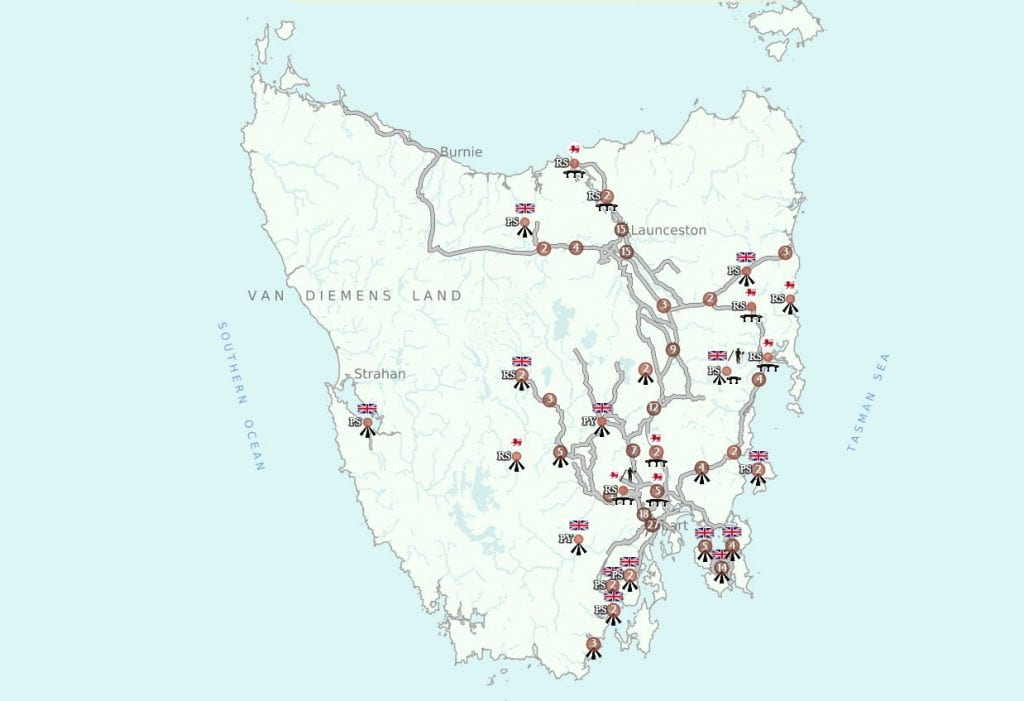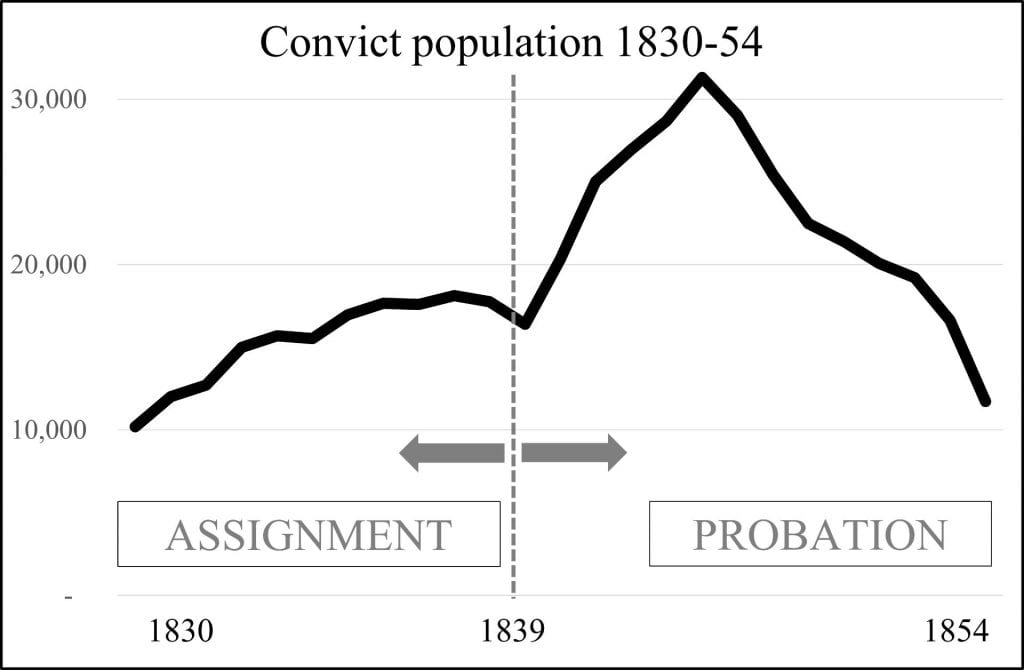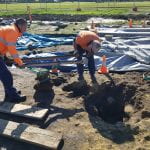When historians and other pointy-headed folk talk about the Australian convict period they generally divide it into two main phases: the assignment period (1814-1839) and the probation period (1839-53). Prior to 1814 all was chaos, starvation and downright anarchy. After 1853 were the twilight years, the convicts disappearing completely at the stroke of midnight, December 31, 1853. This might be a slight exaggeration, but does serve to emphasise how we historically-minded people do love to lump together periods of time and stick labels on them. It’s a great way to deal with history and definitely does not ever cause problems.
The probation system came about due to dissatisfaction with the preceding assignment system. This latter form of convict management had operated in both Van Diemen’s Land and New South Wales. It had seen the majority of male and female prisoners ‘assigned’ to private settlers, working off their sentences in return for board and rations. Road stations, chain gangs, hulks, penal stations and female factories awaited those who misbehaved, or were deemed incorrigible and/or dangerous on first arrival in the colonies. Inevitably, this community-based outsourcing of the justice system began to cause some distress. Some commentators were upset at the ‘lottery’ that convicts faced upon assignment: some could get a terrible master or mistress, other could get a very lenient one. Some were more upset that convicts could get an ‘easy’ ride in comparison to prisoners back in the British Isles. Some were more upset at the suffering that could result. All decided that assignment had to go.

These chaps appear to have lost the lottery (‘Hobart Town chain gang, Charles Bruce [engraver], ca.1830-31, Tasmanian Archives)
Probation was based upon an idea that had first been suggested by Sir John Franklin, Lieutenant-Governor of Van Diemen’s Land in 1837. At this time the colonial government had begun a large program of consolidation, closing stations and placing prisoners where they would be of greatest use to the colony (mostly infrastructure creation like roads, bridges and harbour works). Franklin’s idea was to detain all newly-arrived male prisoners in these stations, subjecting them to a fixed term of servitude responsive to their period of transportation. After this, they would be released to the community to work for wages (passholding, a form of assignment). However, such was the nature of the poorly-planned transition that the regulations were not codified (a set of rules telling station officers and prisoners what to expect) until 1841. These were superseded in 1842 and then again in 1843. Female convicts were left out entirely until 1844, at which they got their own version.
At first things seemed to go well enough. Assignment was to be phased out between 1839-43, withdrawing prisoner labour progressively from urban and then rural areas. Convicts who arrived on the Layton in December 1839 were the first to be listed as ‘probationers’. This was despite there being few stations able to receive them – either already being full, or not designed to match probation’s strict requirements. These required that the convict population of a station be separated into three classes, with prisoners entering at the Third Class and progressing to the First. Each such class had different labour requirements, accommodation and ration allowances attached. The first custom-designed station was Salt Water River, on the Tasman Peninsula. This was formed in March 1841, on land that had been previously cleared by prisoners timber-getting from the nearby Coal Mines (1833-48).

Saltwater River – built by convicts, for convicts (‘Saltwater River’, ca.1890, PH30/1/4574, Tasmanian Archives)
Of course, the closure of New South Wales to transportation put immediate (and seemingly unexpected) pressure on all aspects of Van Diemen’s Land’s convict administration. The Convict Department did not have enough clerks to keep up with the paperwork, let alone men and women to staff the stations. The Commissariat and Ordnance Departments did not have the supplies. The Royal Engineers did not have enough engineers to oversee the construction of stations. At the same time, the colonial populace filled the newspapers with complaints about the withdrawal of convict labour. This shortage perfectly aligned with a massive period of economic expansion in the colony between 1840-42, creating jobs and growth just when the labour was being locked away in new stations.
Prisoners began to emerge from stations in 1842-43. Inevitably, they found a colony much diminished, the jobs and growth a mirage that had evaporated. Unemployed and often considered unemployable, the growing number of men caught in limbo began to be a cause for concern. A number of stations located near populace areas like Perth, Campbell Town, Jerusalem (Colebrook) and Fingal became Hiring Depots. These were places where unemployed passholders could find food and shelter and (more importantly for the government) labour for their upkeep, while awaiting employment.
The prisoner population of the colony peaked in 1846, with 12,630 prisoners located in 66 stations, gangs, depots, barracks and factories around the colony. The isolated Tasman Peninsula had the greatest concentration, with five new stations established during 1841-43 (in addition to Port Arthur, Coal Mines and Point Puer). Throughout the probation period it consistently had around 30% of the colony’s male incarcerated population. Some stations, such as Cascades (Koonya, 1842-55), Impression Bay (Premaydena, 1841-56) and Salt Water River (1841-54) were to be among the longest-lived in the colony. Some, such as Flinders Bay (1841-42, on Forestier’s Peninsula), Wedge Bay (1842-45) and Slopen Island (1841-44) were to be among the shortest.
The year 1846 marked an important turning point. As the population peaked and began to decline, the number of stations consequently began to decrease. This, in turn, meant that the number of administrative staff could be reduced. As unsatisfactory staff were let go, an increasingly experienced core of men and women took over the administration. Places began to adhere to probation’s tenets of classification and prisoner separation, well-supplied by the Commissariat and Ordnance Departments and with building programs properly overseen by Royal Engineer Clerks of Works. The year also marked the inception of an important review into the system, conducted by Charles Joseph La Trobe in 1846-47. The investigation had been triggered by increasing concerns about the impact of probation upon the morality of prisoners, as well as its vast and continuing drain upon Britain’s coffers. The failure of stations to adequately separate prisoners had led to an increasing fixation by authorities upon homosexuality among the convict population, with much ink spilt presenting individual and collective examples in a bid to undermine the system.
Though finding the system much improved, La Trobe’s eventual 1847 report recommended a series of station closures, staff firings and incarceration infrastructure improvement. This was achieved, further aided by a hiatus in transportation between 1846-48. When resumed, transportation continued under the ‘Exile’ system, whereby convicts first served a term of incarceration in the British Isles prior to transportation to the colony. This effectively saw the need for primary probation stations diminish between 1848-53. By the time the last transport arrived in 1853, twelve stations remained – located on the Tasman Peninsula, Hobart and Launceston.
As you can probably tell, the probation system is one of my favourite aspects of Australia’s convict past. It perfectly demonstrates that gap between intent and actuality where we historical archaeologists love to frolic. The ‘system’ as designed was based upon a solid foundation: a period of incarceration where convicts would be reformed through spiritual guidance, education and training, followed by a community-based release program. It was undermined by a host of factors – some of which could never have been foreseen. The vastly increased convict population meant that the supply of essential infrastructure always lagged behind demand. The onset of an economic depression in 1842 saw the job market disappear overnight, meaning that passholders and Ticket of Leave holders were thrown back on the already-stretched resources of the government. This exacerbated overcrowding at stations, leading to a total breakdown of the aims of separation and classification. A moral panic thereby ensued, leading to La Trobe’s commission. The 1840s also marked a time of tension between the colony and Britain, the latter questioning the cost and efficacy of the Treasury’s expenditure. The colony, already in straightened circumstances due to the depression, was forced to shoulder more of the cost. A sharp divide was drawn between those stations managed for colonial purposes and those by the Convict Department (representing British interests). The colony soon came to resent the presence of the latter stations, which became semi-hostile entities in the landscape, drawing on the colony’s resources.
Yet, despite its problems, probation had a massive and lasting impact upon Van Diemen’s Land. Many of its stations went on to become townships, the land cleared and infrastructure built creating a settlement pattern that Tasmania still adheres to. It was a system only implemented in Van Diemen’s Land (as well as its administrative offshoot Norfolk Island), yet was instrumental to the criminal justice systems of an Empire. As such, the unique sites of probation arguably deserve World Heritage-level protection. As you can see from this map, a large number (over 90) of places operated during the 1840s. As Tasmania continues to develop at a rapid pace, we must ensure that these places receive the protection they deserve. If you have or know of a probation-era place, please keep an eye on it. Check with your local and State planning agencies that it has an adequate level of protection. If not, consider doing something about it. These places are finite and, before we know it, will be lost under a wave of development.

Station, gang and establishment locations, 1839-53. Look after them – once they are gone, they are gone for good (our sexy mapping project)




Thank you for your blog site. It is very useful for more context in my convict research (within my Family History Research Diploma at UTAS). This article is great and well-written.
All the best, from a fellow traveler.